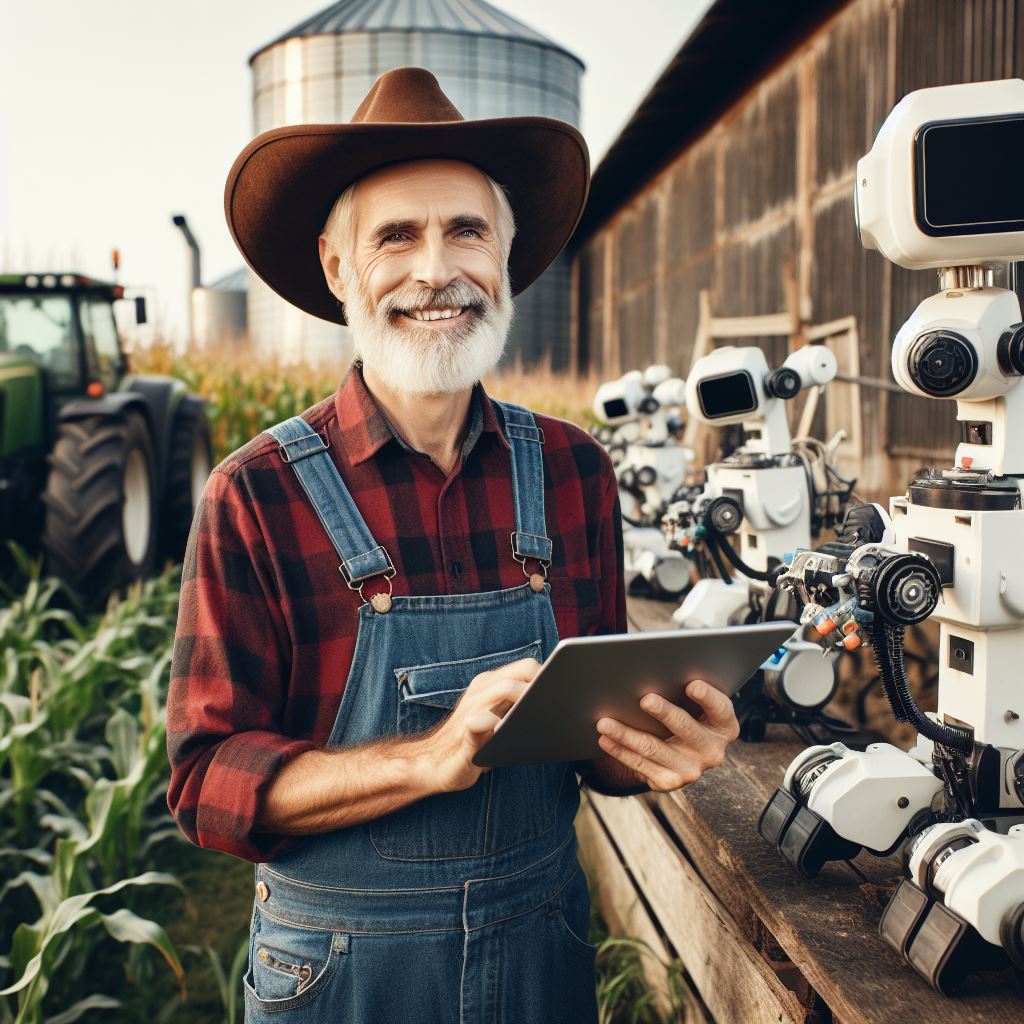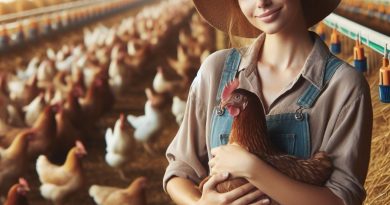Robotic Helpers: Changing the Farming Game
Last Updated on February 28, 2024
Introduction
In today’s dynamic farming landscape, challenges persist despite the industry’s resilience. Farmers grapple with labor shortages, weather uncertainties, and the need for sustainable practices.
Now, imagine a future where these challenges are met head-on by Robotic Helpers. This section explores the transformative impact of robotics in farming, ushering in a new era of efficiency and sustainability.
Traditional farming methods, while time-tested, face limitations in the face of a growing population and environmental concerns.
Robotic technology emerges as a promising solution, offering a paradigm shift in how we cultivate and harvest crops.
In this section, we delve into the role of Robotic Helpers in shaping the future of agriculture.
These machines aren’t replacing farmers; they’re empowering them to focus on strategic decisions while robots handle the repetitive tasks.
As we navigate through the impact of robotics on planting, cultivating, and harvesting, it becomes evident that technology is not a threat to farming traditions but a powerful ally.
The era of Robotic Helpers is dawning, and this sectionis your guide to understanding its implications on the ever-evolving landscape of agriculture.
The Need for Robotic Helpers in Farming
Challenges and Limitations Faced by Farmers
- Labor shortage: Farmers often struggle to find enough skilled workers to perform labor-intensive tasks.
- Physical strain: Traditional farming methods require farmers to engage in repetitive and physically demanding work.
- Time-consuming tasks: Manual activities such as planting, harvesting, and weeding can be extremely time-consuming.
- Weather dependency: Farmers are at the mercy of unpredictable weather conditions, which can affect their crop yield.
- Cost pressures: Rising labor costs and volatile market prices make it challenging for farmers to maintain profitability.
Increasing Demand for Automation in the Industry
- Efficiency and productivity: Robotic helpers offer higher efficiency and productivity as they can work 24/7 without fatigue or breaks.
- Precision farming: Automation allows farmers to utilize precision techniques, such as precise seed placement and targeted herbicide application.
- Reduction in labor costs: By replacing human labor with robots, farmers can significantly reduce their labor expenses.
- Enhanced safety: Robotic systems eliminate the need for humans to perform dangerous tasks, minimizing the risk of injuries.
- Optimal resource utilization: Automated systems can analyze data and optimize resource usage, improving crop yields and reducing waste.
- Consistent quality: Robots can perform tasks consistently, ensuring uniform quality across the farm operations.
- Scalability: Automated systems can easily scale up or down based on the requirements of the farm, offering flexibility to farmers.
In fact, the challenges and limitations faced by farmers in traditional farming methods have led to an increasing demand for robotic helpers in the industry.
Labor shortage, physical strain, time-consuming tasks, weather dependency, and cost pressures have made the adoption of automation a necessity for farmers.
Robotic helpers offer numerous benefits, including increased efficiency and productivity, precision farming, reduced labor costs, enhanced safety, optimal resource utilization, consistent quality, and scalability.
As technology continues to advance, robotic helpers will play a pivotal role in transforming the farming game and ensuring sustainable and profitable agricultural practices.
Read: New Age Farming: Stories from Young Growers
Types of Robotic Helpers
Modern technology has brought significant improvements to various industries, and farming is no exception.
The introduction of robotic helpers has revolutionized the way farmers approach their work, providing increased efficiency, enhanced productivity, and improved sustainability.
In this section, we will explore three main types of robotic helpers: milking robots, harvesting robots, and weeding and spraying robots.
Milking robots
Milking robots have brought a significant transformation to dairy farming. These automated systems have replaced manual labor by carrying out the milking process without the need for human intervention.
One major benefit of using milking robots is the increased efficiency they bring to the farm. Cows can be milked at any time of the day, allowing for a more flexible schedule and higher milk production.
The automation also reduces the physical strain on farmers, improving their overall well-being.
However, it is essential to consider the cost and maintenance requirements of these robots, as well as the potential return on investment.
Harvesting robots
Harvesting robots have proven to be game-changers in the agricultural sector.
They offer numerous advantages over traditional manual labor, including reduced labor costs, increased accuracy, and higher yield.
These robots can work continuously, leading to faster harvesting processes and minimizing the risk of crop damage.
Successful implementation examples include lettuce and strawberry harvesting robots, which have demonstrated significant improvements in efficiency and productivity.
The introduction of these robots has not only benefited farmers but has also positively impacted the supply chain by ensuring consistent and timely delivery of fresh produce to consumers.
Weeding and spraying robots
- Weeding and spraying robots have taken precision agriculture to a whole new level.
- The effectiveness and efficiency of these robots in eliminating weeds and pests have made them indispensable tools on farms.
- Using technologies like computer vision and machine learning, robots precisely identify and target pests, minimizing the need for harmful chemicals.
- This focused spraying approach saves costs, minimizes environmental impact, and preserves soil quality and the surrounding ecosystem by reducing overall chemical usage.
Moreover, these robotic helpers have additional environmental benefits. For instance, weeding and spraying robots can significantly reduce the amount of chemical runoff into water bodies, preventing water pollution.
By targeting specific areas or plants, these robots minimize the need for blanket spraying, reducing chemical exposure and potential harm to beneficial insects and wildlife.
This approach aligns with sustainable farming practices and promotes healthier ecosystems.
In short, robotic helpers have transformed the game of farming by providing efficient solutions to common challenges.
Milking robots, harvesting robots, and weeding and spraying robots have all contributed to increased productivity, reduced labor costs, and improved sustainability.
As technology continues to evolve, we can expect further advancements in the field of robotic farming, paving the way for a more efficient and sustainable agricultural future.
Read: Under 30 Farmers: Changing the Agri-World
How Robotic Helpers are Changing Farming
Farmers have always sought ways to increase their productivity and efficiency in order to meet the growing demand for food.
With the advent of robotic technology, farming has been revolutionized, offering new possibilities for automation and optimization.
Increased productivity and efficiency
Robotic helpers offer the potential for 24/7 operation on farms. Unlike human workers, robots do not require rest, allowing for continuous work.
This means that farmers can significantly increase their productivity by maximizing the time during which tasks are performed.
Furthermore, relying on robotic helpers reduces labor requirements and expenses.
Farmers can save costs by utilizing robots to perform various farming activities, reducing the need for hiring and managing human workers.
This not only saves money but also ensures that farm operations are more efficient.
Improved accuracy and precision
One of the key advantages of employing robots in farming is their ability to perform tasks with great precision.
Robots are programmed to execute specific tasks with accuracy, meaning that the quality of work is consistently high. This leads to improved overall productivity and reduced waste.
Additionally, robotic helpers contribute to higher quality produce and optimized production processes.
With robots tending to crops and livestock, farmers can ensure optimal conditions for growth and minimize errors. This results in better-quality produce and improved resource management.
Enhanced data collection and analysis
- Robots are equipped with sensors and advanced technology that enable them to collect real-time data on various farm parameters.
- This data ranges from soil and weather conditions to livestock behavior and crop health. By collecting this data, robots provide valuable insights for farm management.
- Furthermore, data-driven decision making becomes possible with the help of robotic helpers.
- Analyzing the collected data allows farmers to make informed choices regarding crop rotation, fertilization schedules, irrigation needs, and disease prevention strategies.
- This leads to more efficient resource allocation and improved farm productivity.
In essence, the introduction of robotic helpers has significantly transformed the farming industry.
Their ability to operate continuously, perform tasks with precision, and collect real-time data has revolutionized farming practices.
As technology continues to advance, we can expect even greater innovation in the field of robotic helpers and their impact on agriculture.
Read: Tech Meets Soil: Young Farmers’ Tales

Challenges and Concerns
Potential job implications and impact on rural communities
Automation in farming could lead to a decline in job opportunities for rural communities. It may result in decreased demand for manual labor, affecting the livelihood of many workers.
Rural communities heavily rely on farming as a source of employment and income. The shift towards robotic helpers may exacerbate the issue of unemployment in these areas.
The loss of jobs could lead to a decline in population and economic growth in these communities. As technological advancements continue, retraining programs and new job opportunities must be created.
It is crucial to address the potential job implications to ensure a smooth transition to automation.
Initial investment and cost barriers for farmers
Robotic helpers come with a significant initial investment, which poses a challenge for many farmers. The cost of purchasing and maintaining these advanced machines can be substantial.
Implementing robotic technologies requires farmers to acquire new skills and knowledge. Some farmers may face difficulties in accessing the necessary resources for adopting such technologies.
Financial support and incentives from government or agricultural organizations can help overcome the cost barriers. Collaboration between technology developers and farmers is essential to design cost-effective solutions.
Innovative financing models, such as leasing or shared ownership, can make robotic helpers more accessible.
Safety concerns and necessary precautions
- Introducing robotic helpers into farming operations brings along safety concerns that need to be addressed.
- Farmers must understand the potential risks associated with working alongside these machines.
- Training programs should be provided to ensure farmers know how to operate and maintain the robots safely.
- Safety features should be incorporated into the design of robotic helpers to minimize accidents.
- Regular maintenance and monitoring of robotic systems are necessary to identify and address any issues promptly.
- Increased automation calls for improved safety regulations and standards specific to agricultural robotics.
- Collaboration between industry stakeholders, researchers, and regulatory bodies can help develop comprehensive safety guidelines.
Basically, while robotic helpers offer numerous benefits to the farming industry, some several challenges and concerns need to be considered.
The potential job implications on rural communities require proactive measures such as retraining programs and job creation initiatives.
Initial investment and cost barriers can be overcome through financial support, collaboration, and innovative financing models.
Safety concerns must be a priority, necessitating training, design improvements, regular maintenance, and the development of specific safety guidelines.
By addressing these challenges and concerns, the agricultural sector can embrace robotic helpers while ensuring a sustainable and inclusive transition.
Read: Green Thumbs Up: Youth Transforming Farms
Future Outlook for Robotic Helpers in Farming
Growing Adoption and Advancements in Robotic Technology
The farming industry is increasingly embracing robotic technology to improve efficiency and productivity.
- Robotic helpers have become a game-changer in farming, revolutionizing traditional agricultural practices.
- Farmers are adopting various robotic systems, including autonomous vehicles, drones, and robotic arms, for diverse tasks.
- Advancements in AI and machine learning have enhanced the capabilities of robotic helpers in farming.
- Robots can now handle complex tasks such as crop monitoring, planting, harvesting, and even weed control.
- High-tech sensors and cameras enable robots to gather real-time data about soil conditions, crop health, and yield potential.
- The data collected by robots can be used to make informed decisions and optimize agricultural practices.
- Furthermore, robotic technology reduces the reliance on human labor, overcoming labor shortages in the farming sector.
- Robots can work around the clock, minimizing delays and maximizing productivity, leading to higher crop yields.
- Automated systems also reduce the risk of human errors, resulting in more accurate and consistent farming operations.
Predictions for the Future Role of Robots in Farming
- The future of farming will see even greater integration of robotic helpers in various agricultural processes.
- Robots will continue to evolve and become more versatile, capable of handling a wider range of farming tasks.
- There will be a shift towards swarm robotics, where multiple robots work collaboratively to complete complex farming operations.
- Robotic assistants will play a crucial role in sustainable agriculture by enabling precision farming techniques.
- With advanced algorithms, robots can optimize the use of resources, reduce waste, and minimize environmental impact.
- Robotic helpers will enable farmers to monitor and manage their crops remotely, using data-driven insights to make informed decisions.
- The integration of robotics and IoT (Internet of Things) technology will further enhance the efficiency and effectiveness of farming operations.
- Additionally, robots will contribute to the development of smart farming systems, incorporating advanced analytics and predictive modeling.
- Robotic technology will enable autonomous planting and harvesting on a large scale, making farming more scalable and economically viable.
- As research and development continue, we can expect robots to become an indispensable part of future farming practices.
Potential Areas for Further Research and Development
There is a need for ongoing research and development to improve the capabilities and performance of robotic helpers in farming.
- Efforts should be focused on developing more specialized robots for specific agricultural tasks, such as pesticide application or soil analysis.
- Improved energy efficiency and battery life are crucial to enhance the autonomy and longevity of robotic assistants.
- Investigating the potential integration of AI and machine learning algorithms into robotic systems will further enhance their decision-making abilities.
- Collaborative research between robotics experts and agronomists can lead to innovative solutions for farming challenges.
- Furthermore, addressing the concerns related to data privacy and cybersecurity will be essential for the widespread adoption of robotic technology.
- Investments in training and education programs will be necessary to equip farmers with the skills needed to operate and maintain robotic helpers.
Overall, further research and development will drive the continuous improvement and integration of robotic helpers in farming, transforming the industry.
Conclusion
Agriculture, an industry rooted in tradition, is experiencing a significant transformation with the introduction of robotic helpers.
These technological marvels have proven to be a game-changer, offering numerous benefits and immense potential for the farming sector.
From improving efficiency and productivity to reducing labor costs and increasing crop yields, robotic helpers have already showcased their worth.
These machines can perform monotonous and physically demanding tasks with precision and speed, freeing up human labor for more complex and creative endeavors.
However, it is essential to recognize that this is just the beginning. The farming industry must continuously innovate and invest in the development of new robotic technologies to further capitalize on their potential.
By embracing change and adapting to these advancements, farmers can maximize their profits and ensure sustainable agricultural practices.
The transformative impact of robotics in farming cannot be overstated. With increased automation, farmers will have the tools to tackle challenges such as climate change, labor shortages, and food security.
By harnessing the power of artificial intelligence and machine learning, they can make more informed decisions and optimize resource management.
In closing, the use of robotic helpers presents a bright future for farming.
By recapitulating the multifaceted benefits they bring, emphasizing the need for continuous innovation, and recognizing their transformative impact, it is evident that robotics will play a pivotal role in shaping the future of agriculture.
As technology advances and new breakthroughs occur, the farming game will continue to evolve, ensuring a sustainable and prosperous future for both farmers and consumers alike.



Good article. I’m going through a few of these issues as well..
Yeah? Can you share?